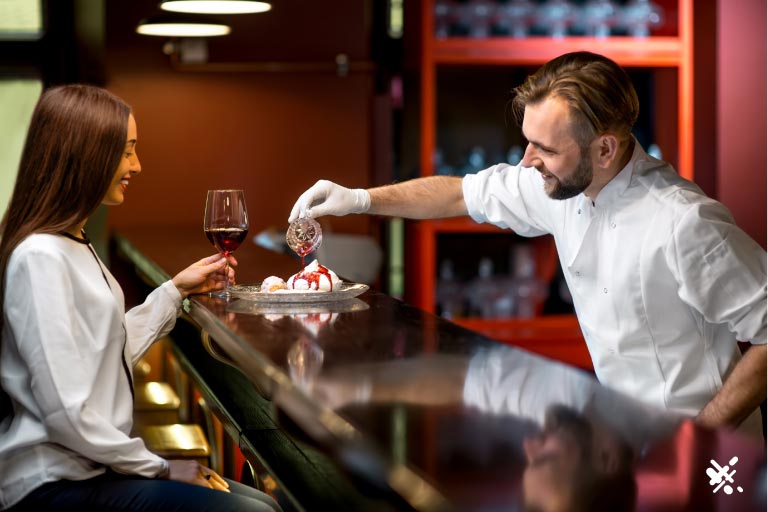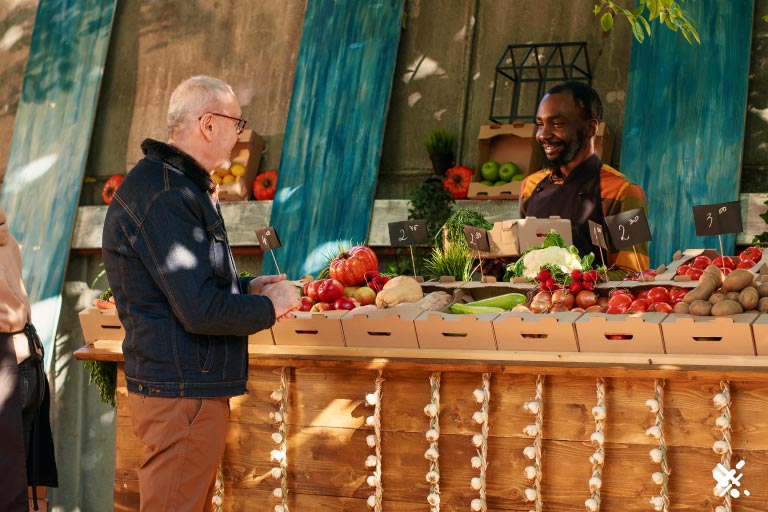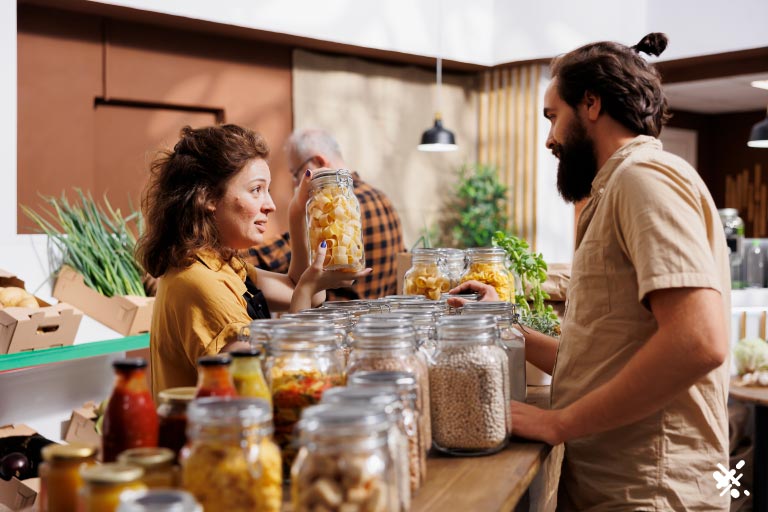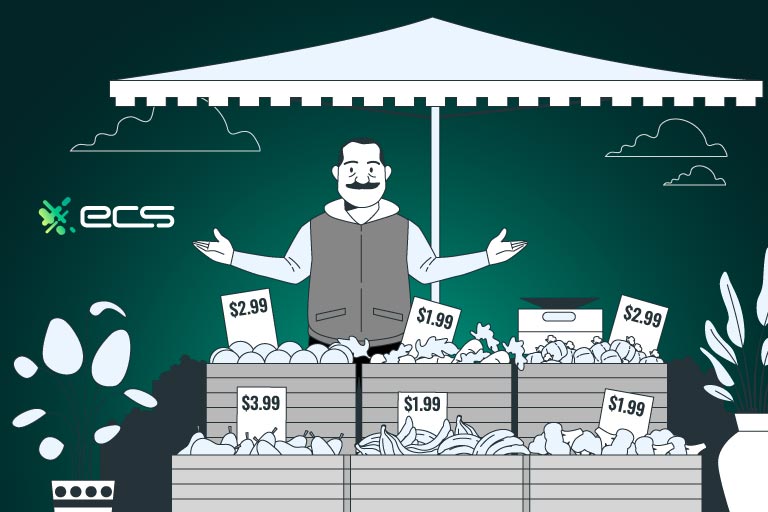Wondering how to lower food costs in your restaurant? Food costs are a big slice of the operating expenses pie, taking up 25-40%. This is about on par with labor costs (30%) but far above rent and utilities (5-10%).
Of course, all these costs will vary from establishment to establishment. But there are a few ways to reduce the cost of food in proportion to your revenue. Let’s grab a fork and dig in.
How To Lower Food Costs in A Restaurant: Use What You Have
One of the best-kept secrets in kitchen management is using food up before it goes bad. However, in order to do that successfully, you will have to get a little…creative.
The particulars of how to reduce food costs in restaurant management differ from category to category (e.g., vegetables, meat, fish, grains), but the underlying rule of thumb is the same: make it last and use every square inch.
Got lots of vegetable scraps lying around? Onion skins, carrot peels, and similar bits of rainbow-colored food waste? Use them to make vegetable stock. Stale bread? Use it to make breadcrumbs.
Fruit beginning to head south for the winter? Freeze it and make smoothies or sorbets. A good chef will know how to squeeze every last drop out of your ingredients, which can significantly reduce your costs.

Special of the Day
One way to implement this strategy on the front end is the special of the day. The special of the day can become a sort of “last chance” for food items to get eaten. Customers find the special of the day appealing because it’s an ever-changing novelty at a price that is often below other menu items (e.g., a bargain).
For example, unsold roasted meats like chicken can be shredded and turned into sandwiches or stews. Did you know that repurposing ingredients to minimize waste has led to the creation of several cultural staples around the world? One of them is Sangria. This fruity wine seems like a luxurious, exotic treat.
But Sangria got a much more ignominious start. Spanish taperias serving wealthier clients would pass the dregs of their wine to the taperia below. To smooth out the haphazard combination of many different wines, fruit was tossed into the vats to sweeten it up with pleasing fruity notes.
Today, getting creative with leftovers can make or break a kitchen. A good chef is skilled at repurposing ingredients to minimize food waste. As food moves towards the end of its shelf life, they know how to recast it into new forms. Sometimes, all it takes is a shredder and a bit of barbecue sauce to squeeze that last bit of value out of your poultry.
Are Your Portions Too Generous?
Penn psychology professor Paul Rozin studied food portions in Europe and the United States. He and his colleagues found that the average meat portion size among all surveyed restaurants in Paris was 277 grams versus 346 grams in restaurants in Philadelphia (a 25% increase). The disparity was even greater in certain subgroups, such as Chinese food: portions in the City of Brotherly Love were a whopping 72% larger than those in the City of Lights.
These bigger portions mean that Americans consume more calories and consequently develop more health issues (obesity, heart disease, hypertension). And while a foray into the health effects of larger portions is certainly worthwhile, we are here to talk about reducing food costs. That said, larger portions may also lead to more waste.
North Americans waste more food than any other demographic group, at 175-295 kilograms per capita. Europe is a close second with 180-280 kilograms, followed by industrialized Asia (155-240), Latin America (200-225), and North Africa and the Middle East (175-210). The average American family spends $2,220 on food they won’t eat, and 44% of food waste is attributable to consumers at home. However, 33% of that food is wasted by restaurants.
Large Portions Equal Large Waste
Could larger, restaurant-sized portions be leading to more waste? Yes. Studies have shown that diners may leave about 17% of their plate untouched, and 55% of those leftovers are not going in a doggy bag.
Portions have increased over the years, with the average dinner plate growing more than 36% between 1960 and today. And as these portion sizes have grown over the years, this means more and more food waste.
Food waste is yet another opportunity to discuss global environmental and geopolitical studies trends. But let’s focus on the business at hand: your bottom line. Bigger portions may mean less profit for your restaurant.
There is only one way to find out: you must monitor the plates coming back into the kitchen. If you notice they still have lots of food on them, you might be too generous with the portion sizes (and lose money while you’re at it).

Food Versus Cuisine: Presentation
Of course, this puts you between a rock and a hard place. You want to compete with other restaurants, and everyone is offering larger portions. If you downsize your portions, you will look like you’re short-changing your diners. But this is where presentation can come into play. Presentation is how you present the food to your customers.
We tend to think of the presentation as being in the domain of elite French restaurants, where a chef who is really an artist (pronounced ar-teest) squirts blended asparagus onto a plate in a latticework pattern before delicately placing just three escargot on top and then utilizing tweezers to garnish each one with an edible flower.
But really, presentation is part of every dining experience. Customers eat with their eyes before they eat with their mouths. Without realizing it, they will examine a plate like a piece of artwork, noting the colors, composition, symmetry, balance, and even mood evoked by the food. Presentation can turn a $20 plate into a $60 plate when done right. And it can also save you lots of money by using smaller amounts of food.
Take grain-based dishes like pasta, for example. You can back a dump truck into a bowl and drop in a mountain of pasta. Or, you can twirl a ladle-sized ball of pasta onto a plate, surround it with sauce, and garnish it. As grains are probably the cheapest products you serve, the savings only increase as you move into other food items (vegetables, meats, etc.).
Find Good Suppliers
Another method for lowering food costs is to improve the pricing and efficiency of your orders. The largest food distributors in America are Sysco and U.S. Foods. But there are also thousands of regional and local food suppliers that restaurant owners can work with.
Food cost management can involve looking at different suppliers for the best pricing on different food items. Some large suppliers like Sysco and U.S. Foods can only sell food in certain quantities. But, when it comes to frequently used products, that might not be a problem.
But when it comes to certain items like specialty products, bulk orders are not a great way to save money. That’s because larger amounts of niche products might be too large for a smaller restaurant, resulting in wasted food and money.
Additionally, larger food suppliers have notoriously higher markups on ancillary items like tin foil and other aluminum products. A general manager may not have the time to parse this out in their cost calculations. However, many restaurant managers have reported that adding tinfoil and paper products to their Costco or SamsClub shopping list has been a great cost-saving measure.
Restaurant owners order from large suppliers to lower the cost of ingredients. However, certain food items may cost less from local or regional suppliers. Produce, fish, and raw meats are often less expensive with local suppliers.
As national suppliers like Sysco are middlemen between the farmer or rancher and the restaurant, cutting out the middleman can cut costs. On the other hand, certain items like sugar, milk, and processed foods will be better pierced than at the grocery store or even a wholesaler like Costco.

Ask…And Ye Shall Receive
Sales reps for most suppliers have a certain amount of flexibility up their sleeves in terms of pricing. They want to build a long-term relationship with their customers. That said, they will do what they can to make sure their pricing fits inside your food budget.
If you show them that another supplier has better pricing, they may be able to match or go lower than that pricing. But you’ll never know unless you ask.
Of course, meal planning, menu pricing, and recipe costing is a lot of work. Restaurant owners and managers are already dealing with a lot between customers and staff members, and of course…preparing food.
Some restaurants attempt to save money on inventory management by placing the chef in charge of ordering with a specific budget. If the chef comes under budget, they can pocket the difference as a bonus.
Smaller restaurants do not typically use this strategy, especially if the chef is paid hourly and not with a salary. However, this practice is fairly common among caterers who charge a fixed price for events.
The chef will be more motivated to reduce food waste and save money because the size of their bonus will depend on how well they do that. They also know that if they cut too many corners, the quality of their food will get them fired, and they’ll have to find a job at Wendy’s—where not even the burgers can cut corners.
Menu Pricing and Inflation
A food cost action plan can focus on how to cut down on food costs. But it can also involve improving your food cost percentage. The FCP is the percentage reflecting the cost of ingredients against the cost of your revenue.
For most restaurants, this number should fall somewhere between 28-35%. Labor costs, rent, and other expenses must also be factored in to determine what food cost percentage will leave you with enough profit.
The way to lower your FCP is obviously to increase your revenue. If your restaurant makes $1,350 per day but spends $400 on food, your FCP is 37%. If you could figure out how to make even just $150 more per day, you would lower it to 33%, which is in the optimal range. There are a few ways to do this, but the two most obvious ones are to increase your prices and/or to get more customers.
However, getting more customers might not be the perfect solution, as you will have to order more food. So you’re left with increasing your menu prices. You do not want to treat this rightly, as your customers will notice. It is something you can do once in a while, and in fact, you will have to do it if the price of raw food goes up.
This basic premise of Food Costing 101 has been painfully familiar to consumers within the last few years. Philadelphia Magazine did a study of a popular (now) $24 burger at Southwark restaurant. Buns are up 78%. Bacon 16%. Beef 4%. Blue cheese 13%. Aioli 25%. Cooking oil 155%. And potatoes a whopping 160%. With astronomical price increases on raw materials such as these, end prices will have to increase.
But is increasing the bottom line the only way? Actually, it is not. You can also inflate the average check size by upselling and cross-selling more profitable food items. You can also use the same strategy to reduce waste (which, in the long run, will also improve your food cost percentage).

Any Drinks Tonight? Upselling and Cross-Selling
Up-selling is the salesy art of getting a customer to order something better. Or, in other words, make an upgrade. Would you like to add cheese to that burger? Bacon? Now you’ve turned a $18 pub burger into a $24 Southwark burger, with up-selling.
Cross-selling is the art of recommending related, lateral items such as sides or beverages. Would you like to pair your burger with a beer? Would you like to have a side of potato salad or perhaps to start off with some onion rings? This type of cross-selling can inflate the check size by a significant percentage.
The key, of course, is to figure out which items you can upsell that will add to the check size more than the grocery bill. Easy examples include beverages and sides made out of items that are on their way through the “product life cycle” (e.g., soup of the day).
Training Staff to Up-sell and Cross-sell
Upselling and cross-selling effectively means you must train your staff or hire the right type of server. Never underestimate the power of a good waiter. Asking, “Do you want to add cheese and bacon?” is often less effective than a mouth-watering suggestion like “Would you care to add some locally sourced gorgonzola and hickory-smoked crispy bacon to your burger?”
Drinks are one area where it’s easy to inflate a check with cross-selling. For many restaurants, wine can be a particularly great way to do this, particularly when done right. Asking, “Do you want anything to drink?” will get far less profitable results than suggesting specific types of wine based on the food (white wine with fish and chicken, red wine with meat, as they say). This is in part because wine offers a high markup potential per glass.
But other types of drinks are also good, especially soda. It’s no secret that soft drinks, in particular, have long been a go-to pricing and profit strategy for fast food restaurants. They can keep their menu prices so low because they make up the difference on other items like soft drinks. You can use this type of strategy to your advantage so that your menu price increases can be restrained.
Full-service menu prices have increased 8% over the past year, while the prices for food at home have risen a little less than 5%. Prices for everything are up, so this puts restaurants in a pinch. With a little strategizing in terms of service, restaurant owners may be able to avoid such significant price increases while still protecting their profit.

How To Fix Food Cost in a Restaurant: Go Local?
Locally sourcing your supplies can also be paired with upselling and cross-selling as a strategy for how to cut food costs in restaurants (or at least keeping the food cost percentage down). Customers are often excited by the prospect of locally sourced food. They think it is more ethical to support local businesses and be sustainable regarding environmental impact.
In fact, 78% of adult diners said they would be more likely to visit a restaurant that has locally sourced food. As mentioned, locally sourcing some items (such as products, fish, and certain kinds of meat) is already a potential plan for how to keep food costs down in a restaurant. But it can also help reduce your food cost percentage by increasing your revenue through sales.
Catchwords like “locally sourced,” “craft brewery,” or “family-owned vineyard” are buzzwords in the food scene. Put these phrases in your menu, on your signage, and let them be intoned by your servers in sonorous, chanting tones of mysterious ritual (okay, maybe that went too far). These green-light words can encourage customers to order a glass of wine, a cup of beer, or an extra side.
Some of these establishments will have their own brand name recognition, especially local breweries, vineyards, and farms. Much like musical artists pair up and feature other artists in their songs, you can feature these items on your menu.
Customers will be more receptive to the idea and may even already have positive associations with those brands. How about our dessert of the week? It’s a peach cobbler made with peaches from [insert local orchard].
Use Analytic Tools
There is yet another way to answer the question of how to keep food costs down in a restaurant: analytics. Analytics is the study of data points, which, in this case, are provided by your customers. Your point of sale (POS) system provides all these data points.
Your POS will tell you what menu items are the most popular. It will tell you what days of the week and times are busiest. And it can even tell you what orders and drinks customers typically pair together.
The science of big data (as it’s called) is helping the food industry in significant ways. Food suppliers are seeing a 46% improvement in demand fulfillment, a 41% improvement in reactivity to supply chain issues, 36% greater integration across the supply chain, 33% inventory optimization, and a 14% shortened order-to-delivery cycle times.
These statistics specifically relate to food suppliers. But restaurants can take a page out of their book for improved operations. The analytic data provided by your payment processing software can tell you what to order and when to order it. It can also tell you what is not selling. You can take this quantitative data and make informed decisions about what to offer on the menu.
It’s hard to analyze all this data unless you are a data scientist. That’s why you need some sort of dashboard that integrates with your point of sale systems and your inventory. These software solutions should specifically be tailored to the restaurant industry, considering the shelf life of different products.
Restaurant Food Cost Reduction Wrap-Up
Using the ingredients you have (every last scrap), reducing portion sizes (in part by creating better presentation), finding good suppliers, menu pricing, up-selling, cross-selling, and going local are great ways to reduce the percentage of profit eaten up by food costs.
Then there are also analytic tools, which are as simple as seeing the most popular orders in your point of sale system. Contact us to learn more about how the POS can help you improve food costs and boost revenue. We’d love to hear from you and learn about your restaurant.
